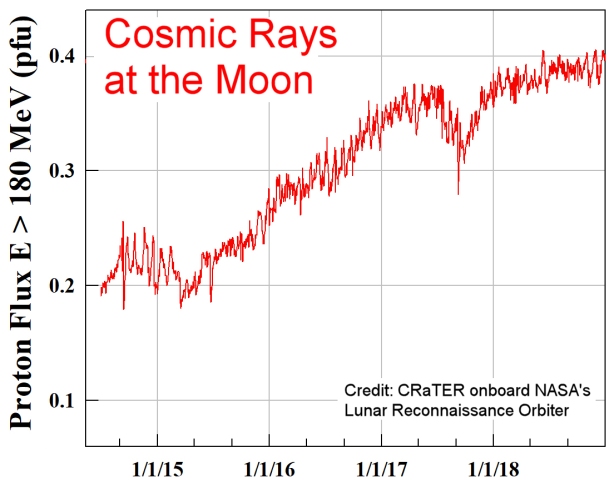July 16, 2019: Note to astronauts: 2019 is not a good year to fly into deep space. In fact, it’s shaping up to be one of the worst of the Space Age.
The reason is, the solar cycle. One of the deepest Solar Minima of the past century is underway now. As the sun’s magnetic field weakens, cosmic rays from deep space are flooding into the solar system, posing potential health risks to astronauts.
NASA is monitoring the situation with a radiation sensor in lunar orbit. The Cosmic Ray Telescope for the Effects of Radiation (CRaTER) has been circling the Moon on NASA’s Lunar Reconnaissance Orbiter spacecraft since 2009. Researchers have just published a paper in the journal Space Weather describing CRaTER’s latest findings.

Above: An artist’s concept of Lunar Reconnaissance Orbiter.
“The overall decrease in solar activity in this period has led to an increased flux of energetic particles, to levels that are approaching those observed during the previous solar minimum in 2009/2010, which was the deepest minimum of the Space Age,” write the authors, led by Cary Zeitlin of NASA’s Johnson Space Flight Center. “The data have implications for human exploration of deep space.”
This always happens during Solar Minimum. As solar activity goes down, cosmic rays go up. The last two Solar Minima have been unusually deep, leading to high cosmic ray fluxes in 2008-2010 and again in 2018-2019. These are the worst years since humans first left Earth in the 1960s.
“It’s a bit counterintuitive,” says one of the authors, Nathan Schwadron, a space physicist at the University of New Hampshire. “Solar Minimum may actually be more dangerous than Solar Maximum.”
In their paper, Zeitlin, Schwadron and co-authors describe an interesting experiment by NASA that highlights the relative peril of solar flares vs. cosmic rays. In 2011, NASA launched the Curiosity rover to Mars. Inside its spacecraft, the rover was protected by about as much shielding (20 gm/cm^2) as a human astronaut would have. A radiation sensor tucked inside kept track of Curiosity’s exposure.
The results were surprising. During the 9-month journey to Mars, radiation from solar flares (including the strongest flare of the previous solar cycle) accounted for only about 5% of Curiosity’s total dose. The remaining 95% came from cosmic rays.
Why the imbalance? “Solar flares of the size we’ve seen during the Space Age can be largely mitigated by achievable depths of spacecraft shielding(1),” explains Zeitlin. “We can’t stop the highest energy cosmic rays, however. They penetrate the walls of any spacecraft.”

Above: Since 2015, the flux of cosmic rays at the Moon has nearly doubled. Another plot shows the complete CRaTER record starting in 2010.
Solar flares are still a concern. If an astronaut were caught outside on EVA during an intense, unexpected flare, acute effects could include vomiting, fatigue, and low blood counts. A quick return to Earth might be required for medical care. Cosmic rays are more insidious, acting slowly, with maladies such as cancer or heart disease showing up years after the exposure.
As 2019 unfolds, Solar Minimum appears to still be deepening. Cosmic rays haven’t quite broken the Space Age record set in 2009-2010, but they’re getting close, only percentage points from the highest values CRaTER has ever recorded.
“No one can predict what will happen next,” says Schwadron. “However, the situation speaks for itself: We are experiencing a period of unusually weak solar cycles. We have to be prepared for strong cosmic rays.”
END NOTES:
(1) According to Zeitlin, “achievable” shielding depths will be at least 20 to 30 gm/cm^2. “Vehicles carrying humans into deep space will likely have storm shelters that will provide this much shielding or more, and that would indeed be sufficient – even for an event like the great solar flare of August 1972 during the Apollo program – to keep the accumulated dose below the 30-day limit.”
REFERENCE:
“Update on Galactic Cosmic Ray Integral Flux Measurements in Lunar Orbit With CRaTER”, by C. Zeitlin, N. A. Schwadron, H. E. Spence, A. P. Jordan, M. D. Looper, J. Wilson, J. E. Mazur, L. W. Townsend. https://agupubs.onlinelibrary.wiley.com/doi/10.1029/2019SW002223

